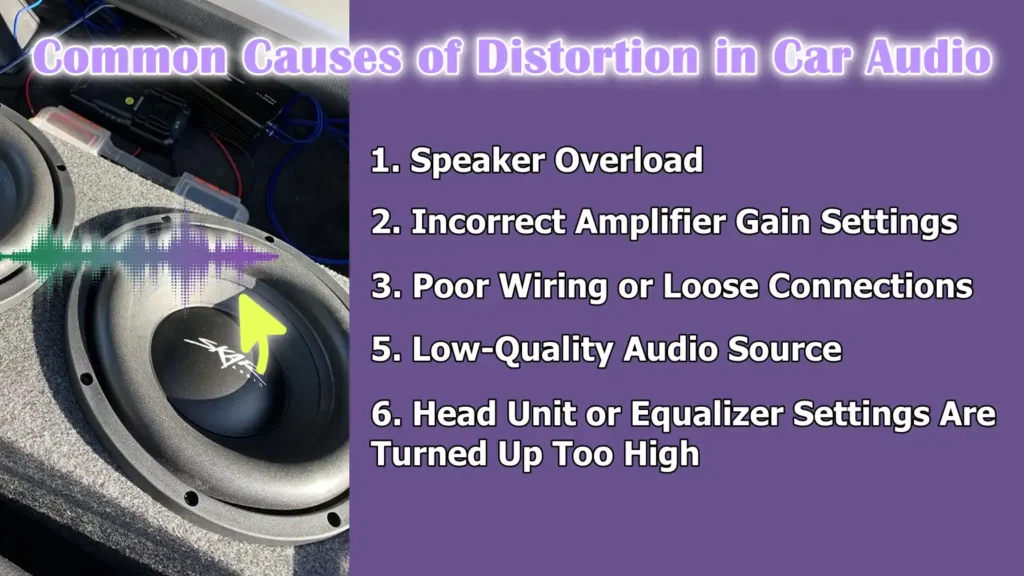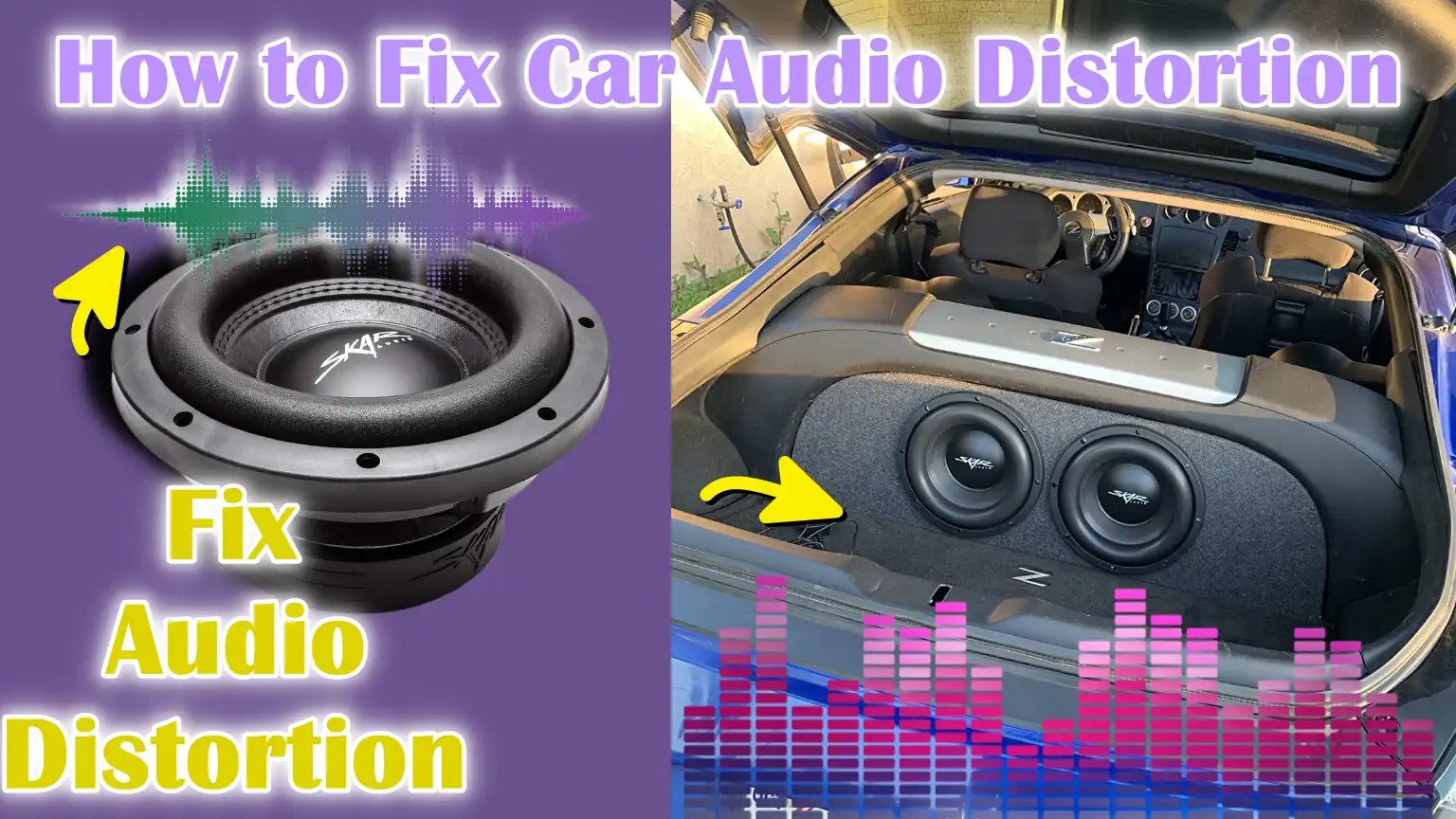Written By: Don Dodi
Fact Checked By: Kristen Brown
Reviewed By: Diego Rosenberg
Basically if you’re car audio has distortion then it is not that your speakers are bad but it is more the way your system is set up actually.
Yes, it the car audio distortion is one of the most common problems that drivers have to face.
But you need to understand that distortion happens when the sound waves from your speakers actually become unclear, fuzzy or harsh and it is often caused by pushing the system beyond its design limits.
And studies in the automotive acoustics also shows that even small mismatches between the amplifier power and speaker handling can lead to the permanent speaker damage and that reduces the sound clarity as well.
Along with this, the audio engineering experts shows that, more than 60% of the distortion issues in cars comes from incorrect amplifier gain settings or poor-quality wiring, as it is not always abut the speakers themselves.
As well as, even the low-quality music files usually which are compressed below 192 kbps, even that can also causes this issue as it removes the key audio details and that file even makes the best systems to sound unclear.
Simply, distortion is not just a sign of a bad sound, but it is more of the warning that your audio system may be overworked, poorly tuned or it is suffering from damaged parts as well.
Now, it is the guide that covers specifically How to Fix Car Audio Distortion, so that you can easily fix this issue and restore the crystal-clear sound again.
Common Causes of Distortion in Car Audio

1. Speaker Overload
Speaker overload occurs when speakers are asked to handle more power than they are designed for.
Every speaker has a rated power range, usually marked as RMS (Root Mean Square) power.
Playing music louder than this limit can overstress the speaker cones, causing distortion or blurring of sound.
Over time, this can permanently damage the speakers, reducing their ability to produce clear audio.
2. Incorrect Amplifier Gain Settings
The amplifier in a car audio system amplifies the signal from the head unit to drive the speakers.
If the gain is set too high, the amplifier sends more power than the speakers can handle, causing distortion.
On the other hand, if the gain is too low, the audio may sound weak or noisy.
Correctly adjusting amplifier gain is crucial to achieving clear and balanced sound.
3. Poor Wiring or Loose Connections
Loose, worn, or low-quality wires can disrupt the smooth flow of electrical signals from the amplifier to the speakers.
Even minor wiring problems can cause crackling, crackling, or distorted sound.
Corroded terminals or improperly connected wires reduce system efficiency and can mimic distortion caused by speaker or amplifier problems.
4. Damaged or Worn Speakers
Speakers with worn, worn, or damaged voice coils will not be able to reproduce sound accurately.
Worn speakers often produce distorted, rattling, or buzzing sounds even at moderate volumes.
Regularly inspecting speaker cones and promptly replacing damaged cones can prevent long-term distortion problems.
5. Low-Quality Audio Source
The quality of the audio file itself plays a major role in sound clarity.
Compressed music files, such as low-bitrate MP3s, remove important audio details, causing distortion when amplified.
Weak signals from Bluetooth or poorly recorded sources can make even high-end audio systems sound unclear.
6. Head Unit or Equalizer Settings Are Turned Up Too High
Modern car stereos and equalizers allow for extensive sound customization, but increasing the bass, treble, or overall volume too much can overload the system.
Increasing certain frequencies too much can cause clipping, resulting in a harsh, distorted sound.
Keeping equalizer settings balanced ensures that the system operates within its intended limits and delivers clear audio.
Basic Initial Diagnostic Steps
1. Listen to Find Where the Distortion Is Occurring
The first step in diagnosing car audio distortion is to listen carefully to determine which part of the sound is affected.
Distortion can occur in the bass (low frequencies), mid frequencies (mid frequencies), or high frequencies (treble).
Knowing the source of the problem helps pinpoint the source.
For example, if distortion is only in the bass, it may indicate a problem with the subwoofer or amplifier, while distorted high frequencies may indicate a problem with the tweeter or head unit settings.
Focusing on these details allows you to systematically address the problem rather than guessing.
2. Testing with Different Audio Sources
Sometimes, distortion may be caused by the audio source rather than the car audio system itself.
Testing the system with different sources, such as radio, Bluetooth, USB, or CD, can reveal whether the problem persists across all sources.
If distortion is present in only one source, it may indicate poor quality files, a weak signal, or device-specific issues.
Using multiple sources helps determine whether the problem lies within the car’s audio system or outside.
3. Check the volume levels of both the head unit and the device
Often, distortion is caused by the volume level of the head unit or connected device being too high.
When both are set close to maximum, the signal can overstrain the amplifier and speakers, resulting in a blurry or crackling sound.
Adjusting the volume to a moderate level and properly balancing them can significantly reduce distortion and help prevent long-term damage to the audio system.
4. Check for speaker-related rattles or buzzes
Sometimes, distortion is not caused by the speakers, but by rattles or buzzes from loose car parts, such as panels, mounts, or trim pieces.
Checking for any loose parts in the dashboard, doors and speaker mounts can prevent these sounds from being mistaken for audio distortion.
Protecting these components ensures that the sound you hear is clear and accurately reflects the performance of your audio system.
How to Fix Car Audio Distortion – Simple Process
1. Adjust Audio Settings
The first step to fixing car audio distortion is to check and adjust the audio settings.
Many distortion problems are caused by the equalizer (EQ) or audio settings being too loud.
Resetting the EQ to a flat setting provides a clean baseline and allows you to gradually adjust the bass, mids and treble without overloading the system.
Reducing excessive bass boost or treble boost prevents the speakers from being overwhelmed and the sound from becoming muffled or harsh.
Additionally, balancing the volume between the head unit and any connected external devices, such as a smartphone or music player, ensures that the system receives a properly scaled signal, reducing distortion and improving overall clarity.
2. Check Amplifier Settings
Amplifier settings play a crucial role in preventing distortion.
The gain on the amplifier must be adjusted correctly, as gain controls the input level of the amp, not the listening volume.
Setting it too high can overload the speakers, while setting it too low can result in a weak or noisy sound.
It’s also important to keep amplifier power in line with the speaker’s RMS rating to avoid overdriving.
Checking crossover settings, including high-pass and low-pass filters, ensures the correct frequencies are being sent to each speaker type, helping to prevent distortion caused by speakers trying to handle frequencies they aren’t designed for.
3. Check Wiring and Connections
Poor wiring is another major cause of car audio distortion.
Check all wires for looseness, corrosion, or wear, as these problems disrupt the smooth flow of electrical signals.
It’s important to ensure the correct polarity of the wires, with proper positive and negative connections, as reversed connections can distort the sound.
If the cables are old or of poor quality, upgrading to better-quality cables improves signal flow and reduces interference, significantly reducing distortion and improving audio clarity.
4. Component Checking and Replacement
Sometimes distortion is caused by damaged or inadequate components.
Replacing speakers can help determine if a specific speaker is experiencing distortion, which could indicate a damaged unit.
Check the speakers for broken cones, damaged voice coils, or signs of wear and replace any worn or underpowered speakers with speakers suitable for your system.
It’s also important to check the amplifier for signs of overheating or malfunction, as a faulty amplifier can cause distortion even if the rest of the system is in good condition.
Replacing faulty components ensures that your car audio system functions reliably and delivers clear, distortion-free sound.
What are The Preventive Measures
So, there’s Total Harmonic Distortion also known as THD, which plays a significant role in the clarity of the car audio systems, as THD levels rise specifically at the higher volumes, then it is seen that distortion becomes more apparent and particularly it affects bass and midrange sounds more. To reduce this, it is actually important to match the amplifier power with the speaker’s specifications and then you have to also adjust the settings to maintain the low THD and in that way you can ensure about the clear and accurate sound reproduction.[¹]
1. Use High-Quality Audio Files
One of the easiest ways to prevent distortion in car audio files is to use high-quality audio files.
Low-bitrate files, such as 128 kbps MP3s, lose a lot of audio information during compression, which can make the sound blurry or unclear when amplified.
Using high-bitrate files, such as 256 kbps or 320 kbps MP3s, or lossless formats like FLAC, ensures that the full range of frequencies reaches your speakers clearly.
This small change can significantly improve sound quality and reduce the likelihood of distortion.
2. Match Speakers and Amplifiers Correctly
Using properly matched equipment is essential to preventing distortion.
Each speaker has a recommended RMS (Root Mean Square) power rating and each amplifier has a power output.
If the amplifier is too powerful for the speaker, it can overdrive the cones and cause distortion or permanent damage.
Conversely, if the amplifier is too weak, the audio may sound weak or noisy.
The combination of the speaker and amplifier ensures smooth power delivery and clear sound.
3. Avoid increasing the head unit volume
Repeatedly playing music at maximum volume on the head unit can strain both the amplifier and speakers, causing distortion.
Even high-end audio systems are designed to operate within a certain range.
Keeping the volume at a moderate level prevents overstraining the system, prolongs the lifespan of your speakers and provides a clearer and more enjoyable listening experience.
4. Insert sound illusions to reduce vibrations
Vibrations inside the car, such as rattling doors, dashboards, or panels, can interfere with sound clarity and may be mistaken for distortion.
Installing sound-dampening materials, such as foam or special mats, helps reduce unwanted vibrations and road noise.
This allows the audio system to produce clear sound without interference and protects the speakers from excess pressure caused by rattling surfaces.
5. Perform regular maintenance on wiring and connections
Electrical connections and wiring in a car’s audio system can deteriorate over time due to heat, vibration, or corrosion.
Regularly inspecting and maintaining wires, terminals and connectors can prevent loose or corroded connections that can cause distortion.
Ensuring all connections are secure and replacing damaged wires as needed maintains the smooth flow of signals, helping to maintain consistent, clear audio performance.
When to Seek Professional Help
1. Persistent Distortion Even After Troubleshooting
If you’ve carefully followed all diagnostic steps and implemented solutions, yet distortion persists, it could be a sign of a serious audio system issue.
Persistent distortion could be caused by subtle issues like internal amplifier malfunctions, hidden wiring problems, or damaged components that aren’t easily visible.
In such cases, consulting a professional ensures the problem is correctly identified and resolved without further damage to your system.
2. Signs of an Amplifier or Head Unit Malfunction
Amplifiers and head units are crucial components of a car audio system and malfunctions in these devices can cause persistent or intermittent distortion.
Signs of malfunction include overheating, unusual sounds, inconsistent output, or complete loss of sound on some channels.
Professional technicians can test and repair these components, calibrate them correctly, or replace them if necessary, which is safer and more reliable than attempting complex repairs yourself.
3. System Upgrade or Rewiring Requirements
Sometimes, system malfunctions occur because the system has been improperly modified or upgraded, or because the existing wiring cannot meet the power requirements of the new components.
Professional help is recommended for rewiring, installing a new amplifier, upgrading speakers, or adding subwoofers.
Technicians have the appropriate equipment and expertise to correctly match equipment, install high-quality wiring and optimize the system for clear, distortion-free performance, ensuring both the safety and longevity of the audio system.
Read More:
Conclusion – How to Fix Car Audio Distortion
It is not just annoying sound, but distortion is actually the signal that there’s room for improvement, as you need to do precise adjustments that protect both speakers and amplifiers and in that way you can achieve clear audio.
By understanding its causes, such as speaker overload, incorrect amplifier settings, poor wiring, or a low-quality audio source, you can prevent permanent damage and enjoy clear, high-quality sound.
Performing a preliminary diagnosis helps pinpoint the source of distortion, while step-by-step solutions like adjusting EQ, checking amplifier gain, inspecting wiring and replacing damaged components restore optimal performance.
Preventive measures like using high-quality audio files, properly matching equipment, avoiding excessive volume and maintaining wiring not only reduce distortion but also extend the lifespan of your audio system.
When problems persist, seeking professional help ensures safe and effective repairs, specially for complex issues or system upgrades.
You can comment down below for more information about this guide, or you can tell us abut your thoughts on this guide.
Frequently Asked Questions
Q1. What causes distortion in car audio?
Answer: Car audio distortion occurs when the sound coming from your speakers becomes unclear, crackly, or blurry. This can happen for a variety of reasons, including playing music at a volume that’s too loud for your speakers, incorrect amplifier settings, damaged or worn speakers, poor wiring or loose connections and low-quality audio files. Sometimes, distortion can also occur when your head unit or equalizer settings are turned up too high. Understanding the cause is important because each type of distortion requires a different solution.
Q2. How can I check if my speakers are causing distortion?
Answer: To check if the speakers are the problem, first listen carefully and identify which part of the sound is distorted, such as the bass, mids, or treble. You can also temporarily replace the speakers. If the distortion is in the speakers, they’re likely damaged or worn. Checking for cracks in the speaker cone or damage to the voice coil can help determine if it needs to be replaced.
Q3. Can adjusting the equalizer fix distortion?
Answer: Yes, adjusting the equalizer can often fix distortion. Many problems occur when bass, treble, or other frequency settings are too high. Resetting the equalizer to flat settings and adjusting them gradually can prevent overstressing the speakers. Reducing excessive bass or treble boosting can help the system play clearer sound without straining any components. Balancing the volume between the head unit and connected devices also improves clarity and reduces distortion.
Q4. Why does distortion occur at high volumes?
Answer: Distortion at high volumes usually occurs because speakers are being asked to handle more power than they are designed for. Every speaker has a specific power range and exceeding this limit can stretch the cones beyond their limits, resulting in a blurry or harsh sound. High volume can also overstrain the amplifier, leading to clipping, a common cause of distortion. Keeping the volume at a moderate level helps protect the system and ensure clear audio.
Q5. Can low-quality music files cause distortion?
Answer: Yes, low-quality music files are a common cause of distortion. Low-bitrate files, such as 128 kbps MP3s, lose important audio details during compression. When these files are played on high-power speakers, the loss of audio detail can cause a harsh or unclear sound. Using high-bitrate files, such as 256 kbps or 320 kbps, or lossless formats like FLAC, ensures that the audio retains its full quality and reduces distortion.
References:
[1] Audio Engineering Society Convention Paper, In-Vehicle Audio System Distortion Audibility versus Level and Its Impact on Perceived Sound Quality
https://www.listeninc.com/wp/media/2023/06/141_AES_Car_audio_distortion_ST_PD.pdf

Guys, I’m a car audio enthusiast and customization expert and I love clear sound and clean installation. Plus, I have spent years helping people build their dream audio setups. And whenever I’m working on cars, I probably listen to music and thinks about the next big upgrade.

